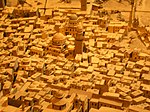The Heritage House
1985 establishments in IsraelHostelsHotels established in 1985Hotels in JerusalemNon-profit organizations based in Israel
The Heritage House is a non-profit youth hostel in the Jewish Quarter of the Old City of Jerusalem. It offers free or subsidized lodging to Jews from around the world. The hostel provides young Jewish adults with information on touring, studying, intern, and work opportunities in Israel, in addition to providing follow-up connections, especially with the Jewish communities back in their home towns around the world.
Excerpt from the Wikipedia article The Heritage House (License: CC BY-SA 3.0, Authors).The Heritage House
Hurva Plaza, Jerusalem Old City
Geographical coordinates (GPS) Address Nearby Places Show on map
Geographical coordinates (GPS)
| Latitude | Longitude |
|---|---|
| N 31.775444444444 ° | E 35.231805555556 ° |
Address
רחבת החורבה
Hurva Plaza
Jerusalem, Old City
Jerusalem District, Israel
Open on Google Maps









